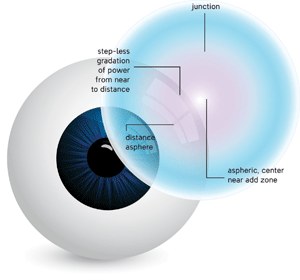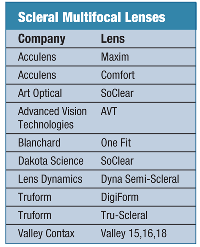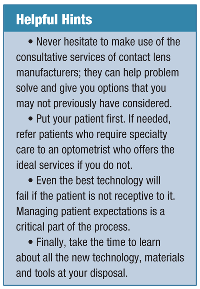Few conditions are as much of a “sure thing” as presbyopia—we see it all day long in our clinical practice. Unfortunately, although the condition is pervasive, enthusiasm for contact lens correction of it is not. Patients are generally unaware of the concept, and practitioners often consider it too much hassle except in ideal circumstances. Too often, both parties opt for the path of least resistance—spectacle lenses. Why bother with tricky contact lens fittings when there are cheaper, easier alternatives? Because we shouldn’t have to ask patients to compromise their goals, and we practitioners shouldn’t “take a dive” when we know we have the skills to truly achieve those goals.
In this article, I will provide an overview of the modalities available today to better serve our presbyopic patients’ visual demands.
Early Pioneers
Benjamin Franklin, frustrated with the effects of presbyopia, created the first spectacle bifocal lens in 1784.1 But the desire and concept to correct vision via alternative means, aside from the spectacle lens, first began in 1508 with Leonardo da Vinci; he suggested using water in direct contact with the eye to alter the optics of the visual system for correction of refractive error.2 In 1887, a German glassblower named F.A. Muller crafted and successfully fit a glass contact lens using a mold of a person’s eye to ensure proper curvature, a technique developed by Sir John Herschel. The first soft contact lens bifocal lens was introduced in 1982.2

1. Schematic drawing of the SynergEyes Duette multifocal lens.
From spectacle bifocal lenses to contact lenses, art and science continue to work together to achieve refractive correction that doesn’t compromise near vision.
The Challenge
Many of our patients who are now showing signs of presbyopia have worn contact lenses successfully in the past, and wish to continue to do so without having to switch to spectacles to correct for their near demands. Our patients want clear, crisp optics at all focal lengths, without having to sacrifice a specific distance in one eye to allow another to be brought into focus. In addition, it is important to factor in the visual demands of today’s patients, which are becoming increasingly more complex and are placing greater strain on the eye due to the increased use of mobile devices that require good near vision—laptops, tablet computers, smart phones and GPS systems, to name a few. Practitioners have to correct for this growing incidence of refractive error.
Industry continues to provide today’s practitioners with multiple tools to help meet these demands. The first step is to listen and take inventory of your patient’s lifestyle and corresponding visual demands. Details about occupations, hobbies and leisure-time activities will allow you to determine which contact lens modality is the best fit for your patient.
Along with accounting for the patient’s refractive error, we must address any ocular anomalies that may be present. Some of the challenges in fitting a multifocal contact lens include lid anatomy, irregular cornea shape, corneal ectasia, ocular surface disease or previous ocular surgeries.
 Our Approaches
Our Approaches
With the visual demands of our patients escalating, it is increasingly important to be able to provide the whole visual range without compromise.
Here is an overview of the different approaches:
• Monovision. The monovision fitting approach has been used by many practitioners, and done so very successfully. However, because a stronger add is needed for close demands, the intermediate distance will become more of a challenge, or vice versa.
• Bifocals. One approach is to modify the monovision setup by using a pure distance correction in the individual’s stronger distance eye, and then fit a bifocal contact lens in the fellow eye. In the stronger near eye, set the distance portion of the bifocal lens for intermediate range, coupled with a lower add to allow for near demands (e.g., cell phone use or reading printed materials). This fitting approach can be applied to soft and gas-permeable (GP) lenses.
• Toric multifocals. Compound or mixed astigmatism, combined with presbyopic changes, can be a challenge when fitting a contact lens patient. Advances in lens stabilization, materials and lathing techniques have allowed manufacturers to offer toric multifocal soft contact lenses.
For example, SpecialEyes offers its 54 Multifocal Toric lens with a base curve of 6.9mm to 9.5mm, a diameter range of 12.5mm to 16.0mm, plano powers to +/-25.00D, add up to +3.00 in 0.10D increments and cylinder power of -0.50D to -8.00D in full circle axis.3 Additional options for soft toric multifocal contact lenses would include: Proclear Multifocal Toric DW (CooperVision), Synergy Translating Bifocal (Gelflex USA), Satureyes Multifocal Toric (Metro Optics), Metrofocal Toric (Metro Optics), C-Vue Advanced Toric Multifocal (Unilens Corporation), C-Vue 55 Toric Multifocal (Unilens Corporation), MVT (Unilens Corporation) and UCL Sonic View Toric (United Contact Lens).11
• Hybrid multifocals. Another option to address astigmatism, myopia or hyperopia along with a presbyopic correction is the hybrid multifocal contact lens. For instance, the Duette Multifocal (SynergEyes) combines an 84 Dk silicone hydrogel skirt with a 130 Dk rigid GP center in a 14.5mm diameter lens (figure 1).4 The manufacturer claims that up to 6.00D of corneal astigmatism can be addressed with its hybrid lens for spherical power ranges of +5.00D to -15.00D and effective range of add power in the near zone is from +0.0D to +2.25D.5
• Gas-permeables. GP contact lens manufacturers also offer a wide range of parameters in multifocal optics. One example, of the many available, is the Lifestyle RGP (Bausch + Lomb) lens, which features Paragon HDS material. The lenses have a base curve of 6.82mm to 8.76mm, an add power range from +1.75D to +3.00D, and are available in diameters of 9.0mm, 9.5mm and 10.0mm.6
• Sclerals. The birth of scleral lenses dates back to 1887 when F.A. Muller first created his glass contact lens, which covered the anterior surface of the eye.1 During the early 1940s, scleral contact lenses fell out of favor due to concerns of hypoxia. Today, with new developments of materials, software and manufacturing techniques, we have enjoyed a resurgence of these lenses.7
 This reintroduction has been particularly useful for practitioners who work with irregular corneas (e.g., keratoconus, keratoglobus, pellucid marginal degeneration, postoperative corneas, post trauma and ocular surface disease), high levels of toricity, anterior dystrophies and high prescriptions.8 Keep in mind that many of these patients are, or will become, presbyopic. Several of today’s scleral manufactures can produce lenses that allow for near vision enhancement, such as Maxim Plus (Acculens), SoClear (Art Optical and Dakota Science), Valley 15, 16 and 18 (Valley Contax), and DigiForm and Tru-Scleral (Truform). Several scleral manufacturing companies currently offer a scleral contact lens in a multifocal modality (see “Scleral Multifocal Lenses”).10
This reintroduction has been particularly useful for practitioners who work with irregular corneas (e.g., keratoconus, keratoglobus, pellucid marginal degeneration, postoperative corneas, post trauma and ocular surface disease), high levels of toricity, anterior dystrophies and high prescriptions.8 Keep in mind that many of these patients are, or will become, presbyopic. Several of today’s scleral manufactures can produce lenses that allow for near vision enhancement, such as Maxim Plus (Acculens), SoClear (Art Optical and Dakota Science), Valley 15, 16 and 18 (Valley Contax), and DigiForm and Tru-Scleral (Truform). Several scleral manufacturing companies currently offer a scleral contact lens in a multifocal modality (see “Scleral Multifocal Lenses”).10
The Maxim Plus scleral lens has a central aspheric add on the anterior surface of the lens and is available in a diameter range of 15.7mm to 20.5mm, power +/- 20.00D, cylinder to -6.00D, and adds from +1.00D to +3.50D. This lens is manufactured using Boston XO2 material with 140 Dk. The manufacturer will provide a fitting set to diagnose the patient. A custom order is then processed and the lens is made.
Also, the Comfort SL Plus (Acculens) scleral lens is intended for a normal cornea and has the option of adding a center add on the front surface. These lenses are available in diameters of 15.7mm to 20.5mm, power +/- 20.00D, toric to -6.00D, and adds from +1.00 to +3.50D. Although it uses the Boston XO2 material, no fitting set is needed. Instead, an empirical fitting is performed by providing the company with the patient’s K readings, prescription and corneal diameter.9
As a practitioner, it is always our goal to do all that we can to give our patients the best vision possible. Thankfully, industry innovation and new technology have provided us with some solid options to help many of our patients who are interested in continued contact lenses wear––including those with changing refractive errors or underlying medical conditions that warrant the wear of contact lens correction.
Dr. Pfeil is a partner in Eye-Care Specialties in Lincoln, NE. While providing primary eye care services, he focuses on specialty contact lens fittings and sits on a practitioner advisory panel for SynergEyes.
1. Berris M. The inventions and scientific achievements of Benjamin Franklin. Available at:
http://inventors.about.com/od/fstartinventors/ss/Franklin_invent_4.htm (accessed June 2012).
2. Heiting G. When contact lenses were invented. 2010 Jan. Available at:
www.allaboutvision.com/contacts/faq/when-invented.htm (accessed June 2012).
3. Tyler’s Quarterly Soft Contact Lens Parameter Guide. 2011 Dec;29(1).
4. Duette Lens. 2012. Available at:
http://duettelens.com/DMF_2.html (accessed June 2012).
5. SynergEyes, Inc. Duette Multifocal product literature. 2012.
6. Gas Permeable Institute. Searchable database of GP lenses. Available at:
www.gpli.info/asp/search.aspx (accessed July 2012).
7. Sindt C. Basic scleral lens fitting and design: Scleral contact lenses are an important tool when fitting challenging patients. CL Spectrum. 2008 Oct.
8. van der Worp E. A guide to scleral lens fitting. Contact Lens Education Society. 2010. Available at:
http://commons.pacificu.edu/mono/4/ (accessed June 2012).
9. Acculens. Product literature for Maxium scleral lens and Comfort SL Plus scleral lens. Available at:
www.acculens.com (accessed July 2012).
10. DeNaeyer G. Today’s scleral lenses. Rev Cornea Contact Lenses. 2012 June;149(5):18-22.
11. Tyler’s Quarterly Soft Contact Lens Parameter Guide. 2011 September.


